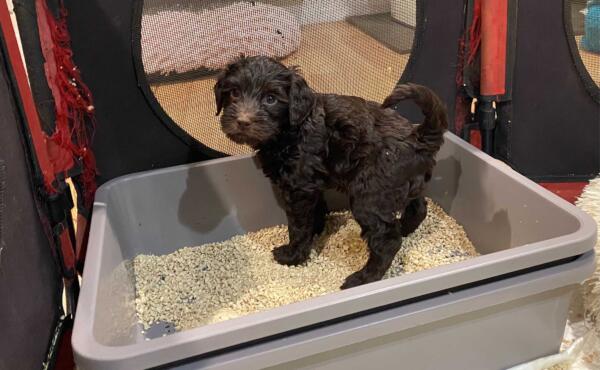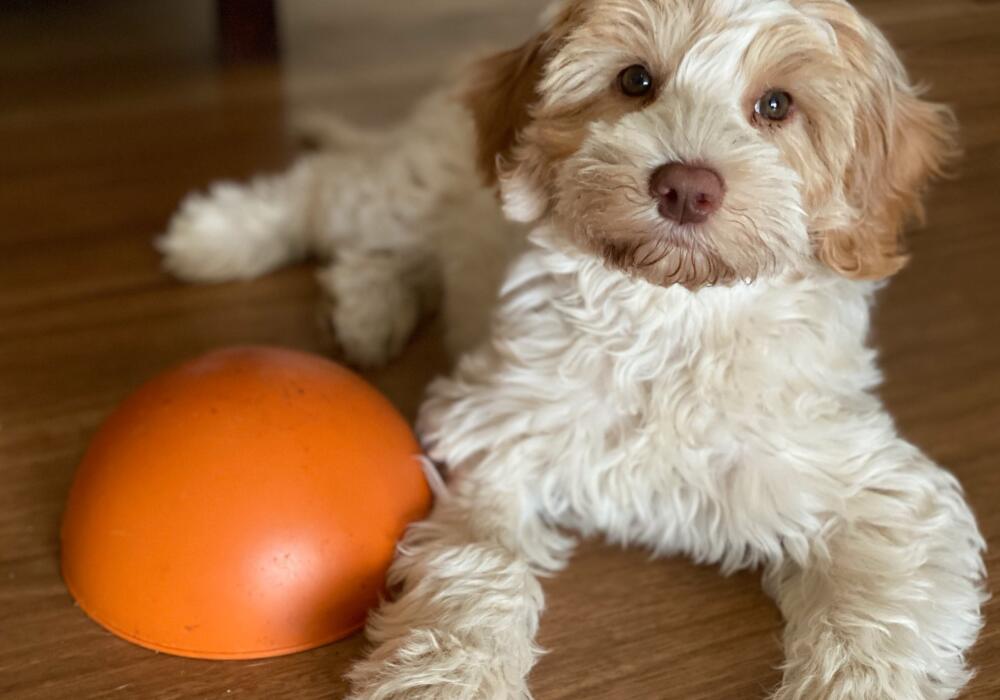We recently received a lovely email from a family who have worked really hard to help their bundle of fluff develop into an accomplished Amalie Labradoodle. But there is a huge amount of effort that goes on behind the scenes as well as expertise to produce puppies that are reasonably well prepared by 8 weeks to transition into their new homes. It’s expected that you may have some sleepless nights, some puppy puddles and some casualties (think computer cables, lego bits and other things forgotten at puppy level) along the way but it is a journey and here we talk about a few key aspects that make that transition as easy as possible.
Mastering the basics
We spend a lot of time sequentially developing the skills puppies need for appropriate toileting (right place, right time, healthy poops) and that starts with their mother’s care. In the first few weeks, puppies are unable to toilet on their own and a mother will lick to initiate toileting (yes, wee and poo) and the licking also ensures that puppies remain clean and dry. This is important for their growth and development as wet puppies are cold puppies and this can lead to a failure to thrive or survive.
Pups will transition to a whelping box set up with a soft sleeping spot and a toileting space that we clean as often as needed (multiple times a day). They naturally don’t want to poop the nest so their instinct is to move away from the sleeping space… we are just supporting their natural instinct to help them develop good habits. Sometimes we will also litter train our pups. Once they transition outside, the same principles apply and our pups will go out the doggy door to toilet outside overnight.
The big question – will they have good toilet behaviours at home? Yes, if provided with the right opportunity and are guided to apply what they have learned with us, in a new setting. This will require good observation skills on your behalf.

Manners and boundaries
There are many building blocks that shape successful puppy development. Boundaries are an important aspect of creating good manners – just like young children, puppies benefit from routine, time for play and exploration, time for learning (training), some time each day (start with 5 min) spent on his own and the majority of time allocated for rest. This is time available for the brain to consolidate new information. You can appreciate that learning step-by-step in a sequential way as well as consistency in communication and reward are important aspects of your approach as your puppy learns. Inconsistency creates mental obstacles and sends mixed messages that can confuse the puppy. Consistency will make it easier for the puppy to decode the messages he receives, verbal and non-verbal and makes the task of learning more straightforward for him (or her).
Did you know that stepping off on yours right foot has a different meaning to the puppy than stepping off with your left? I use “Left, let’s go” to mean follow me…. right is used when I want the puppy to wait or stay. We start puppy training with following games – the begining of leash training.
Temperament
Temperament is a complex blend of nature (genetics and factors inherited from mum and dad) and nurture (the care and socialisation of mum, breeder and new family). The nurture element is fluid and changes, as learning is life long. Experiences shape the puppy and his behaviours all the time – behaviours can be shaped and re-shaped. Selecting sound breeding stock is an important job of all breeders – when breeding Labradoodles, health and temperament are foremost considerations. That said, it is easy to unravel good work with experiences that are not optimally handled. Compounding that, there are fear periods to consider as well as your response to a negative or scary situation and none of us is perfect 100% of the time. The key is to be observant, get help when needed and don’t let problems continue once you identify them by teaching a different response. As your own behaviours and responses are somewhat programmed too, you may benefit from the advice of a trainer so together with your pup, you can learn new ways to approach old problems.
Matching puppies and families
When breeders say that they allocate rather than allow families to choose a pup, many people are put off or disappointed. However, in my experience, when given a choice, families more often than not are overwhelmed and find it difficult to choose which puppy to invite into the family. The breeder on the other hand has been observing the pup throughout its development and with the right information from families regarding what they are looking for in a pup, the breeder should be able to allocate the right pup from a litter or advise a different pairing if nothing in a current litter is going to hit the brief. Sometimes waiting is a good option – just because Labradoodles look like teddybears doesn’t mean they have teddybear temperament and just want to chill and cuddle on the couch. Understanding the family and their expectations of their pup is the beginning of puppy allocations.
Did you know that many dogs do not like to be cuddled? and that putting your arms around their back conflicts with their own ideas about body language? In our world, it means affection but in the dog world, it is usually perceived as a threat. For your pup, just being close to you can be enough. This is an important lesson for parents to teach children and there are some great online resources here
♠ Liam Perk Foundation
♠ Blog post on dogs and hugs
On the spot support
We will always be around to help problem solve with our puppy families – through all stages of life. Please don’t hesitate to call! Just because we have selected wonderful breeding stock, considered where your life is at and where you hope it to lead before allocating a pup and started each and every pup off on the right foot, does not mean that things will be smooth and easy as your pup transitions to a new home or moves through life stages. If we can provide advice, we will. Sometimes you may not like it when I say, for example, that it appears you have dropped the ball and your pup has taken advantage of the situation. It’s not a criticism, just an observation and with that information, we are able to plot a path and get things back into a better groove. This might be back to bootcamp training for a few months, revisiting boundaries, doing things differently and setting a higher bar for your dog through something like trick training or agility. Our aim is to help you to get the most out of life together.

